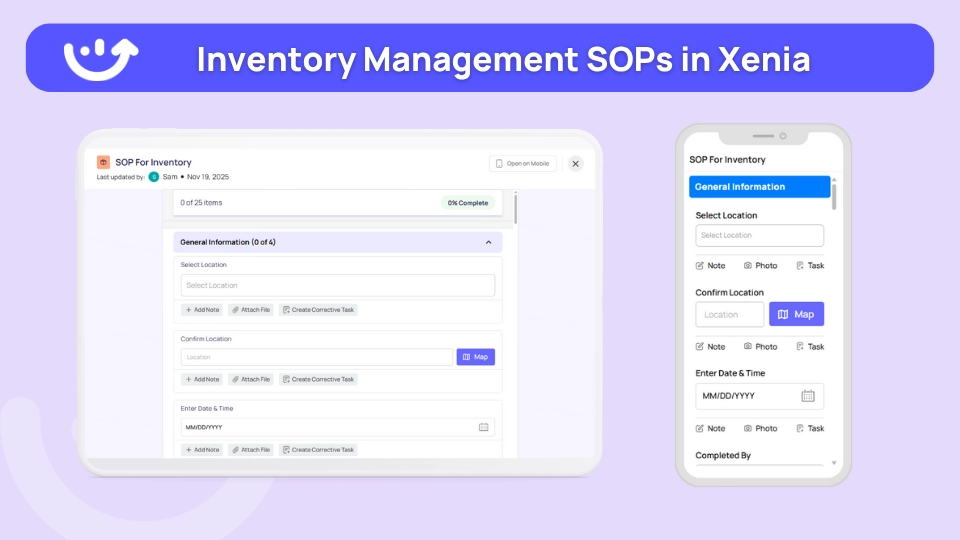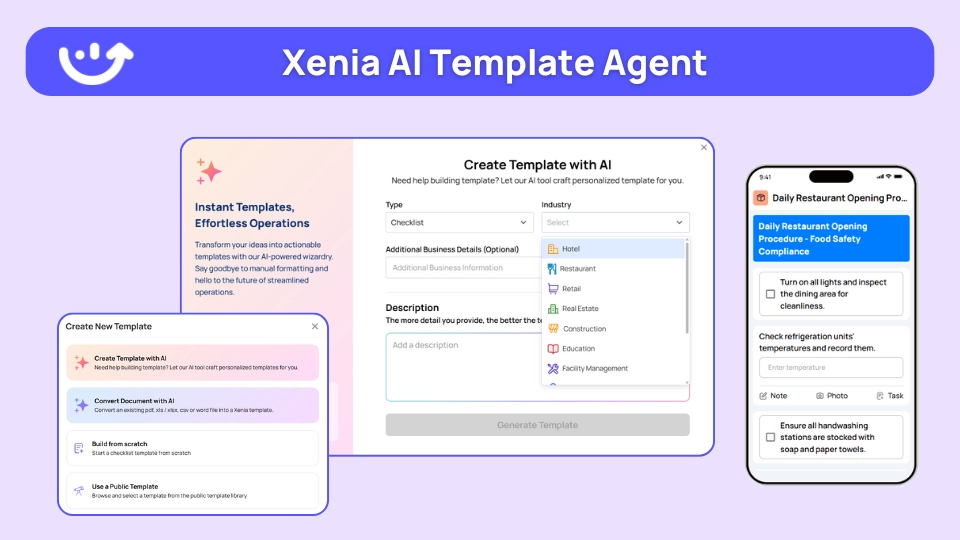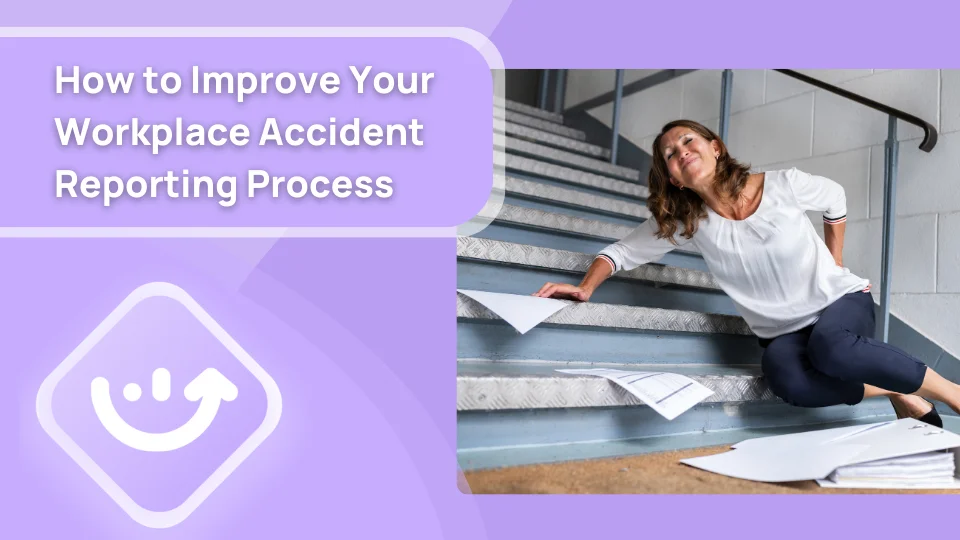The Deepwater Horizon oil rig explosion in 2010 is a disaster we all know of, releasing approximately 134 million gallons of oil.
However, hours before that, crew members noticed abnormal pressure test readings, but they were ignored. A near-miss, which, if given attention, would have stopped the hazard from happening.
That's where incident reporting plays a crucial and clear role, identifying and resolving near-misses, near-hits, close calls, unsafe behaviours, before they become a hazard.
Workplace accident reporting, which was once a tedious task, has become simpler, more advanced, and smarter with the use of digital tools. No matter what your business is about, you need an incident reporting system to make your workplace safer, maintain legal & regulatory compliance, and reduce overall risk.

.svg)

Priced on per user or per location basis
Available on iOS, Android and Web
The Hidden Costs of Inefficient Accident Reporting
Incident Reporting is a critical component of operations execution, and even a small inefficiency can have a significant impact on overall safety. Let's find out how:
- Slow reporting and response times
- Delayed or missed detection of hazards and risks
- Data inconsistencies and inaccuracy
- Compliance risks caused by incomplete documentation and an audit failure
- Limited visibility that may affect corrective strategies
- Incident costs and compliance penalties
- Slower corrective actions implementation
- Prolonged downtime or risk exposure due to inefficient processes
- Lack of coordination in follow-up actions
- Loss of customer trust due to repeated safety issues
Signs Your Workplace Accident Reporting Is Inefficient
Every incident reporting process has its own friction points. Let’s say, even if your employees reported the near-miss immediately, the concern doesn't always reach the attention of the managers.
Alternatively, the information may arrive incomplete, forcing managers to seek out missing facts before taking action. To help you understand how efficient your current reporting workflows are, we have listed the key indicators for you:
- Reliance on Manual Reporting: Your team continues to use outdated and manual methods, such as paper-based checklists and manual data entry, to report incidents.
- Inconsistent Reporting and Escalation Process: Reporting lacks a consistent framework, and there is no uniform escalation process across all locations. The primary cause is that teams use different formats, incidents go unreported, data gets lost, or there is no authentication for the collected data.
- Delay in Reporting: For every incident, if there is a delay in reporting, there is a high probability that you will miss the window for strategic impact.
- High Financial Losses: If you notice high financial losses, particularly in compensation, repair costs, or regulatory fines, it may be a sign that you need to upgrade your incident reporting.
- Recurring Incidents: Recurring incidents often signal inefficiency in incident reporting and root cause analysis.
- Lack of Transparency: You may miss out on critical insights and reduce accountability, which could lead to the repetition of unsafe behavior.
- No Data Trails for Incidents: Missing logs that track incidents can hinder the linking of recurring issues and the identification of the root cause.
- Incomplete Data Records for Incidents: Your data trails for incident reports have unclassified, unprioritized, or incomplete information.
5 Steps for Building Standardized Workplace Accident Reporting Procedures
Missed incident reporting can be costly, as you will likely agree. Most companies focus on finding a solution.
One crucial step they miss is understanding why it is happening. Did the employees take care of the incident, thinking it wasn’t that big of a deal? Or simply ignored because what can a minor slip do? Or, the worker present at the site reported the incident, but you were never updated?
The reason so many accidents go unreported, or the reported incidents are never addressed by the concerned team, is due to a flawed incident reporting procedure. So, to fix that problem, here’s a detailed 5-step workplace reporting procedure:
1. Immediate Alert and Response
All employees, be it a sales associate at a retail store or a maintenance crew lead, should know what to do when something unexpected happens. So, the first step is to provide your teams with access to tools that will initiate the reporting process.
Businesses in the digital age utilize reporting channels with mobile accessibility and offline capabilities to ensure reporting is as fast as possible.
With reporting tools such as pre-built checklists, forms, and instant alerts, the identified issue can be easily escalated to the concerned people with no delay.
Note: If you use a workplace accident reporting channel, it should provide easy and intuitive reporting so that employees can file incidents without confusion or delays.

2. Incident Data Gathering and Documentation
The next and most crucial step of incident reporting is to collect and document detailed information about the incident.
And you must note that reporting doesn't mean you have to report only major events, such as retail theft, equipment failure, or injury. Employees must escalate alerts for near misses, minor injuries, or unsafe behaviors to ensure prompt attention and resolution.
Here's what all should be covered in your documentation:
- Basic information, including date, time, and location of the incident.
- Description of what happened chronologically, along with accurate facts.
- Names and contact details of all the people affected or present, along with any injuries.
- Data trails for damage to assets or equipment.
- Supporting documents as evidence, which can include photos, videos, etc.
- Data trail for immediate response and preventive maintenance (compliance logs, repairs, or audits) in the past.
- Any factors that link to the incident.
‘We are already recording all this data, what’s the difference?’, that’s your exact thought right now. What if the time or location mentioned is not correct in your records?
Digital tools help make data gathering more authentic by allowing you to add fields such as timestamps, geo-tags, photo/video attachments, and digital signatures, ensuring that you have all the necessary evidence documented.

Pro tip: You can conduct interviews with people who were present at the time of the event and record their statements.
3. Know Why the Incident Happened
Now, with all the data you have collected, you need to find out the potential cause and impact of the incident. Instead of manually hunting for patterns and insights using spreadsheets, you can use incident reporting software that performs advanced analytics and provides you with insights like:
- Incident Frequency & Trends
- Root cause & Contributing Factors
- Financial Impact Analysis
- Compliance and Regulatory Insights
- Employee Training Requirements
4. Find a Fix
Now that you have all the information, you can take actionable and practical steps to mitigate the incident's impact & recover the incurred loss. Implementing corrective actions is not a single event; it begins at the outset and continues throughout the process.
Corrective action can be anything that fixes the problem and prevents its recurrence, such as automating the escalation of work orders or sending instant alerts to managers.
5. Review and Update Safety Measures
At this point, the incident has been reported and documented, with recovery efforts underway to mitigate financial, operational, reputational, safety, and property losses. But your work isn't done yet.
You must review, track, and evaluate whether the incident reporting and corrective strategy was effective or not. Here's how:
- Monitor KPIs for incident rates, near-miss reports, equipment failures, quality defects, etc.
- Perform follow-up inspections and audits.
- Observe compliance and regulatory needs.
- Implement training for the employees in the required areas.

The Role of Digital Transformation in Safety Reporting
You now have a roadmap to create an incident reporting system, but what if you could automate tasks like alerting or escalation instead of managing everything manually?
Incident reporting platforms like Xenia handle these workflows for you, reducing the burden on your teams while making the process faster and more reliable.
1. Speed and Automation Where It Matters
Seconds count when incidents happen. A spill can become a fall, a leak can turn into a chemical hazard. That's why real-time alerts are built into modern reporting tools, teams get notified immediately when something goes wrong.
Automated task escalation removes the guesswork from critical moments. When an incident is reported, the system routes it to the right person automatically. Your safety officer gets the full report, maintenance gets their repair tasks, and everyone knows what they need to do without waiting for manual assignments.
2. Clear Visibility Across Your Operations
Live dashboards give you real-time visibility into what's happening and what's being done about it.
Role-based views ensure everyone sees what matters to them EHS officers get full incident reports and trend analytics, while maintenance teams focus on their specific repair tasks.
Categorization helps you make sense of your data. Organize incidents by type, severity, location, status, or priority. When you need to pull reports or spot patterns, everything is already sorted.
Find out how operational dashboards differ from analytical dashboards and which one you should choose.
3. Intelligence Built Into the Workflow

Creating incident forms doesn't have to take hours. Xenia's AI Template Agent builds incident reporting checklists in seconds, letting you customize fields for your specific needs without starting from scratch.
Intelligent trigger systems respond to what actually happens during reporting.
A "yes" response to hazard presence sends instant alerts. Scores falling below critical levels activate escalation protocols. Activity in high-risk areas triggers additional review steps.
Multi-level conditional logic means your forms adapt in real time. With branching logic, the reporting process expands or contracts based on the answers people give, capturing exactly the information you need without overwhelming reporters with irrelevant questions.
Xenia's AI photo analysis assesses damage or risk from uploaded images, giving you proactive insights before problems escalate. For historical and current incidents, AI-powered summaries highlight critical issues, task patterns, and trends that help you prevent future incidents.

4. Communication and Compliance That Work Together
Built-in chat keeps teams connected. Share findings, add comments, update incident status, and attach evidence all in one place where everyone can see the full picture.
Compliance maintenance happens naturally when every incident is documented, managed, and resolved according to regulatory standards. Your audit trail builds itself as your team does their work.
Offline reporting capabilities mean location never limits safety. Employees can submit reports and alerts from anywhere, even without internet connectivity. When they reconnect, everything syncs automatically.
5. Turning Data Into Prevention
Real-time data helps you spot patterns before they become problems. Risk assessment becomes proactive when you can identify trends across locations, shifts, or incident types.
Modern platforms also function as learning management systems, letting you upload training modules that improve how effectively your team reports and responds to incidents.
Get Started with Digital Safety Transformation with Xenia
Workplace accident reporting, often neglected in business operations, is the key pillar of workplace safety.
With every near-miss or event that has the potential to become a hazard being identified, resolved, and monitored promptly. And with technological integration, utilizing tools such as digital checklists, live dashboards, and automated alerting systems.
In this article, we discuss how to identify gaps in your existing reporting workflows and provide solutions for enhancing workplace safety.
With our 6-step guide, you can establish a standard incident reporting protocol that will address every incident, regardless of its size or severity.
Explore how you can make reporting smarter at every step with Xenia’s digital reporting tool. Book a free 14-day trial to establish your own incident reporting protocol with Xenia.For any doubts, book our demo and speak with industry experts.

.svg)
.webp)
%201%20(1).webp)






.svg)
%201%20(2).webp)








